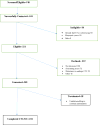Computed Tomography Colonography vs Colonoscopy for Colorectal Cancer Surveillance After Surgery
- PMID: 29174927
- PMCID: PMC5847443
- DOI: 10.1053/j.gastro.2017.11.025
Computed Tomography Colonography vs Colonoscopy for Colorectal Cancer Surveillance After Surgery
Abstract
Background & aims: Recommendations for surveillance after curative surgery for colorectal cancer (CRC) include a 1-year post-resection abdominal-pelvic computed tomography (CT) scan and optical colonoscopy (OC). CT colonography (CTC), when used in CRC screening, effectively identifies colorectal polyps ≥10 mm and cancers. We performed a prospective study to determine whether CTC, concurrent with CT, could substitute for OC in CRC surveillance.
Methods: Our study enrolled 231 patients with resected stage 0-III CRC, identified at 5 tertiary care academic centers. Approximately 1 year after surgery, participants underwent outpatient CTC plus CT, followed by same-day OC. CTC results were revealed after endoscopic visualization of sequential colonic segments, which were re-examined for discordant findings. The primary outcome was performance of CTC in the detection of colorectal adenomas and cancers using endoscopy as the reference standard.
Results: Of the 231 participants, 116 (50.2%) had polyps of any size or histology identified by OC, and 15.6% had conventional adenomas and/or serrated polyps ≥6 mm. No intra-luminal cancers were detected. CTC detected patients with polyps of ≥6 mm with 44.0% sensitivity (95% CI, 30.2-57.8) and 93.4% specificity (95% CI, 89.7-97.0). CTC detected polyps ≥10 mm with 76.9% sensitivity (95% CI, 54.0-99.8) and 89.0% specificity (95% CI, 84.8-93.1). Similar values were found when only adenomatous polyps were considered. The negative predictive value of CTC for adenomas ≥6 mm was 90.7% (95% CI, 86.7-94.5) and for adenomas ≥10 mm the negative predictive value was 98.6% (95% CI, 97.0-100).
Conclusions: In a CRC surveillance population 1 year following resection, CTC was inferior to OC for detecting patients with polyps ≥6 mm. Clinical Trials.gov Registration Number: NCT02143115.
Keywords: CT Colonography; Colonoscopy; Colorectal Cancer; Surveillance.
Copyright © 2018 AGA Institute. Published by Elsevier Inc. All rights reserved.
Conflict of interest statement
No author reports any significant potential conflicts.
Figures
Similar articles
-
Diagnostic accuracy of laxative-free computed tomographic colonography for detection of adenomatous polyps in asymptomatic adults: a prospective evaluation.Ann Intern Med. 2012 May 15;156(10):692-702. doi: 10.7326/0003-4819-156-10-201205150-00005. Ann Intern Med. 2012. PMID: 22586008
-
Post-operative colorectal cancer surveillance: preference for optical colonoscopy over computerized tomographic colonography.Cancer Causes Control. 2019 Nov;30(11):1269-1273. doi: 10.1007/s10552-019-01231-w. Epub 2019 Sep 17. Cancer Causes Control. 2019. PMID: 31531798 Free PMC article. Clinical Trial.
-
Utility of computed tomographic colonography in surveillance for hereditary nonpolyposis colorectal cancer syndrome.Fam Cancer. 2007;6(1):135-40. doi: 10.1007/s10689-007-9116-1. Fam Cancer. 2007. PMID: 17273816
-
Flat colon polyps: what should radiologists know?Clin Radiol. 2010 Dec;65(12):958-66. doi: 10.1016/j.crad.2010.05.008. Epub 2010 Sep 17. Clin Radiol. 2010. PMID: 21070898 Review.
-
Computed tomographic colonography (CTC): Possibilities and limitations of clinical application in colorectal polyps and cancer.Technol Cancer Res Treat. 2004 Apr;3(2):201-7. doi: 10.1177/153303460400300213. Technol Cancer Res Treat. 2004. PMID: 15059026 Review.
Cited by
-
Cost-effectiveness analysis of alternative colon cancer screening strategies in the context of the French national screening program.Therap Adv Gastroenterol. 2020 Sep 20;13:1756284820953364. doi: 10.1177/1756284820953364. eCollection 2020. Therap Adv Gastroenterol. 2020. PMID: 33014138 Free PMC article.
-
Radiologic Imaging Modalities for Colorectal Cancer.Dig Dis Sci. 2022 Jul;67(7):2792-2804. doi: 10.1007/s10620-021-07166-0. Epub 2021 Jul 30. Dig Dis Sci. 2022. PMID: 34328590 Review.
-
CT Colonography and Colorectal Carcinoma: Current Trends and Emerging Developments.Cureus. 2022 May 11;14(5):e24916. doi: 10.7759/cureus.24916. eCollection 2022 May. Cureus. 2022. PMID: 35719832 Free PMC article. Review.
-
A Head-to-Head Comparison of Computed Tomography Colonography, Optical Colonoscopy, and Colon Endoscopic Capsule for the Detection of Polyps After Partial Colectomy or Rectosigmoidectomy for Colorectal Cancer: A Pilot Study.Cureus. 2023 May 1;15(5):e38410. doi: 10.7759/cureus.38410. eCollection 2023 May. Cureus. 2023. PMID: 37273390 Free PMC article.
-
British Society of Gastroenterology/Association of Coloproctology of Great Britain and Ireland/Public Health England post-polypectomy and post-colorectal cancer resection surveillance guidelines.Gut. 2020 Feb;69(2):201-223. doi: 10.1136/gutjnl-2019-319858. Epub 2019 Nov 27. Gut. 2020. PMID: 31776230 Free PMC article.
References
-
- Siegel RL, Miller KD, Jemal A. Cancer statistics, 2016. CA Cancer J Clin. 2016;66:7–30. - PubMed
-
- Mariotto AB, Rowland JH, Ries LA, et al. Multiple cancer prevalence: a growing challenge in long-term survivorship. Cancer Epidemiol Biomarkers Prev. 2007;16:566–71. - PubMed
-
- Cooper GS, Kou TD, Reynolds HL., Jr Receipt of guideline-recommended followup in older colorectal cancer survivors : a population-based analysis. Cancer. 2008;113:2029–37. - PubMed
-
- Hines RB, Barrett A, Twumasi-Ankrah P, et al. Predictors of guideline treatment nonadherence and the impact on survival in patients with colorectal cancer. J Natl Compr Canc Netw. 2015;13:51–60. - PubMed
-
- Benson AB, 3rd, Venook AP, Bekaii-Saab T, et al. Colon cancer, version 3.2014. J Natl Compr Canc Netw. 2014;12:1028–59. - PubMed
Publication types
MeSH terms
Associated data
Grants and funding
LinkOut - more resources
Full Text Sources
Other Literature Sources
Medical


